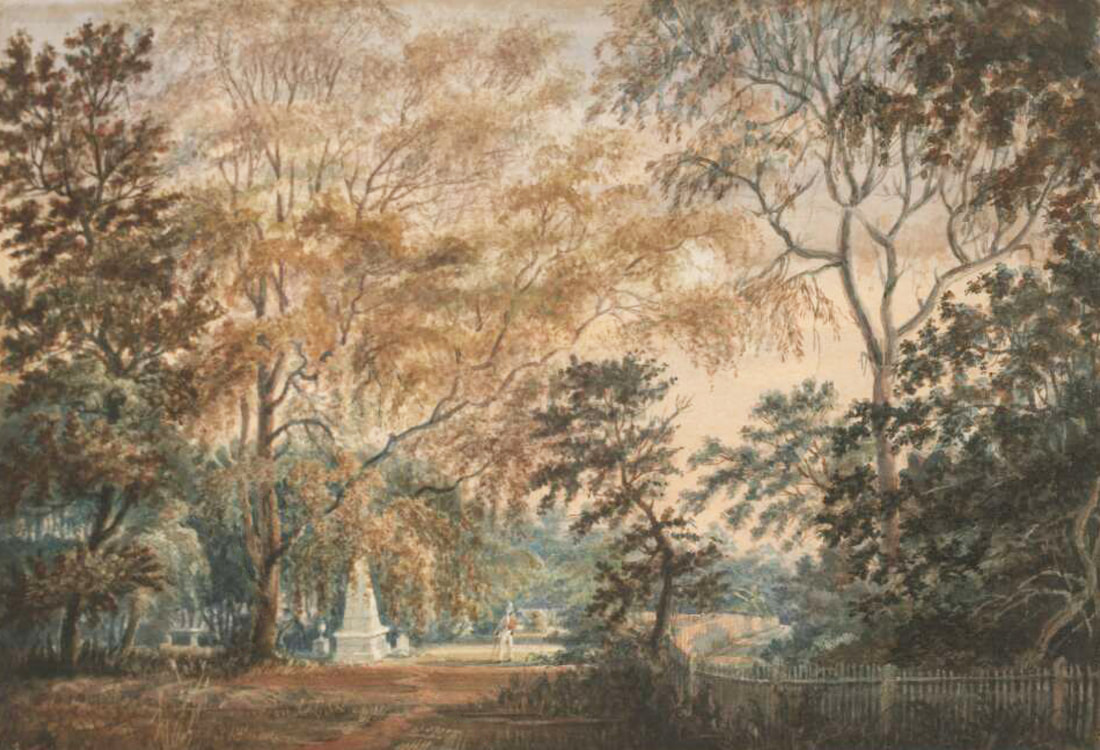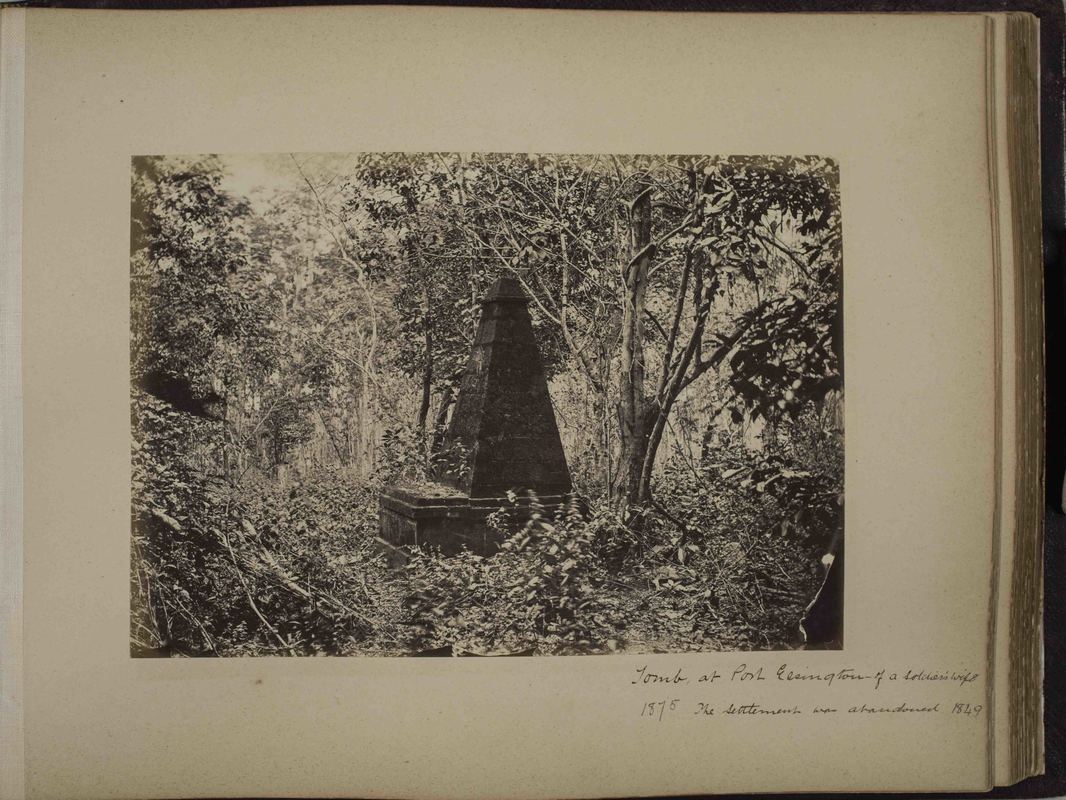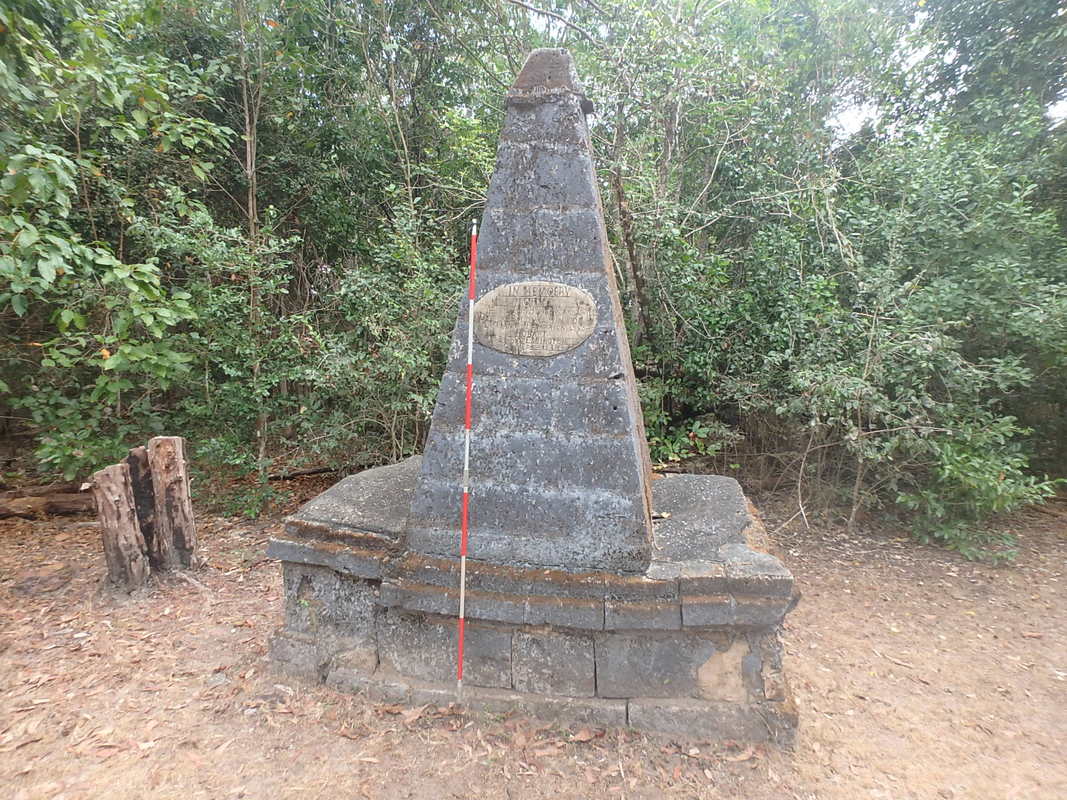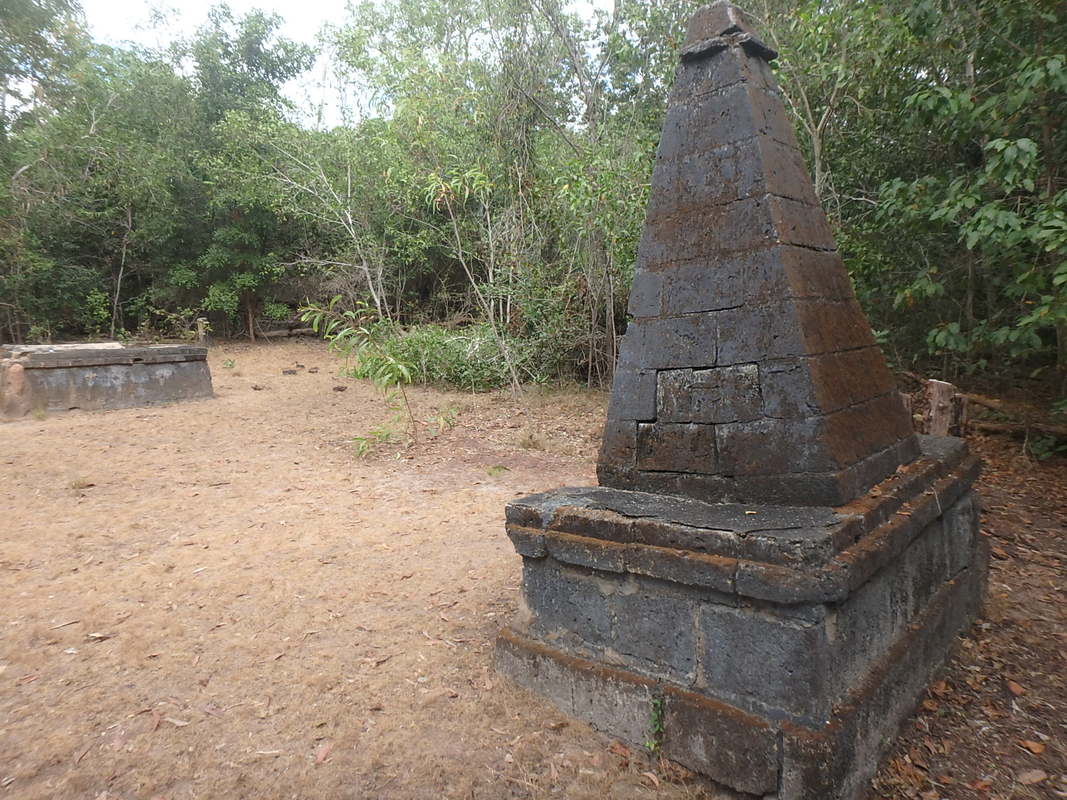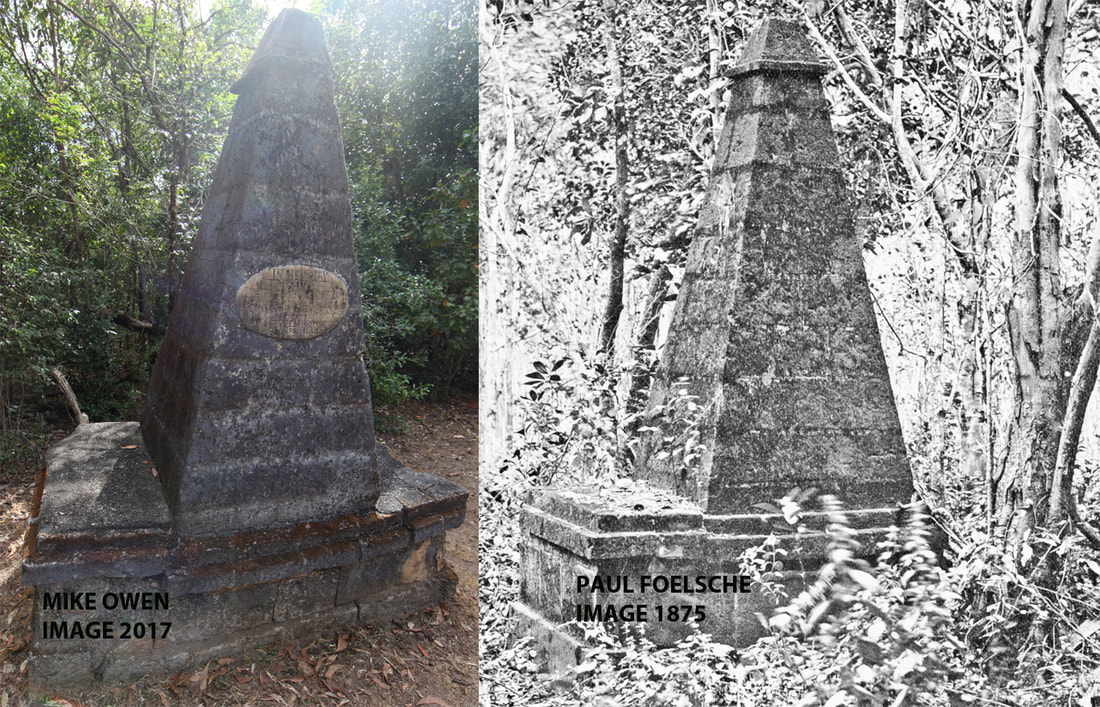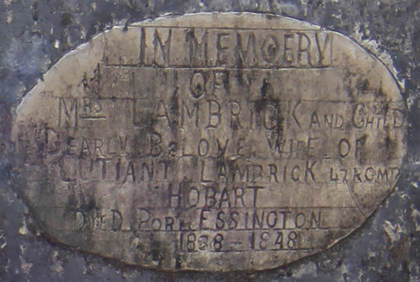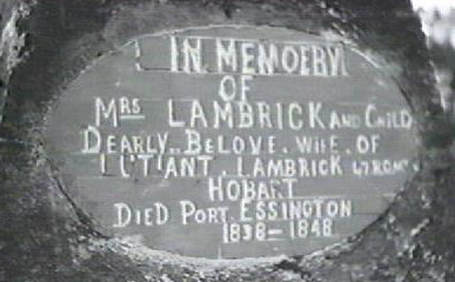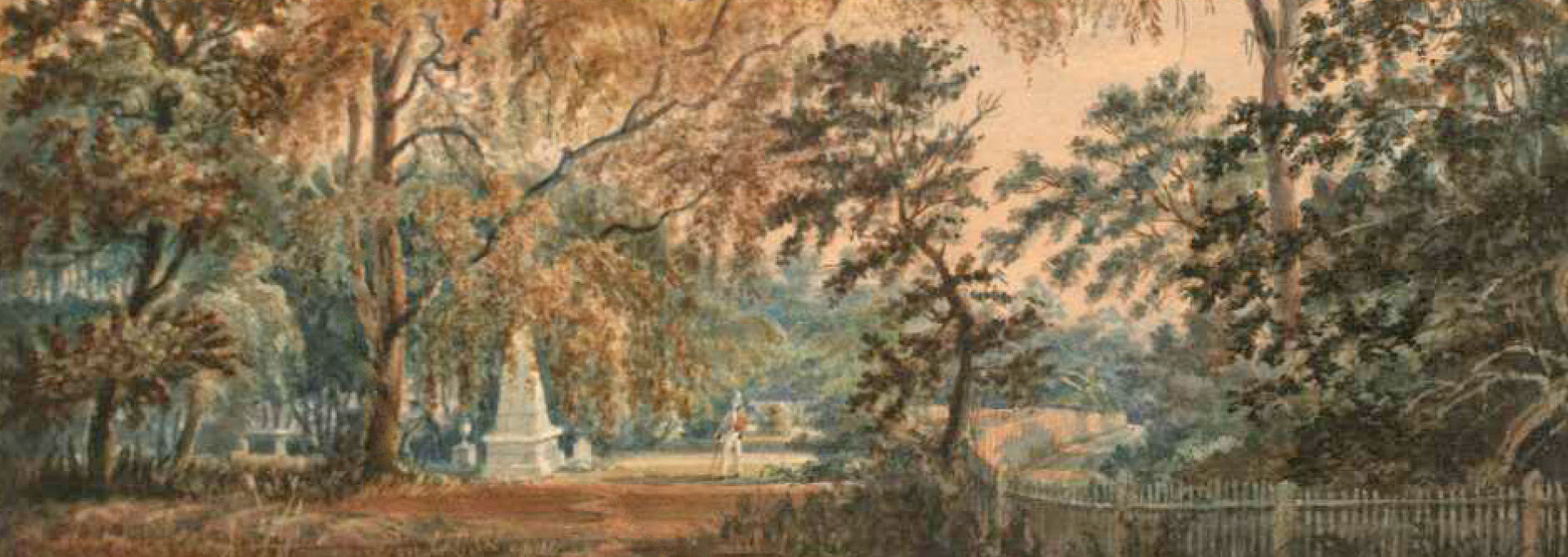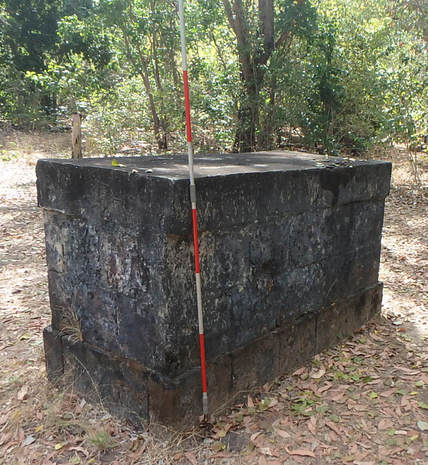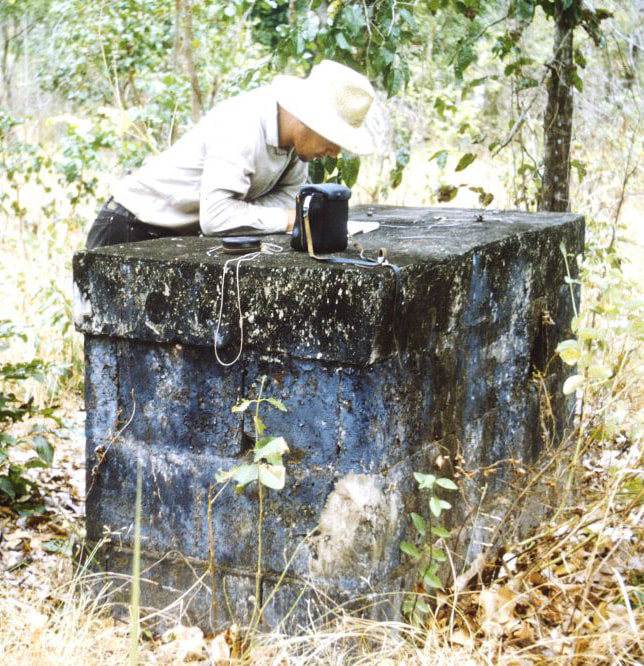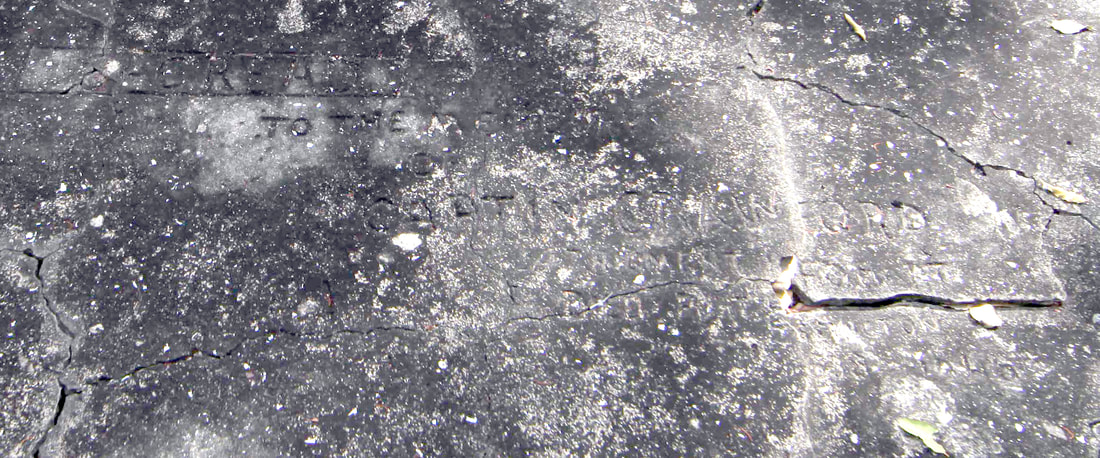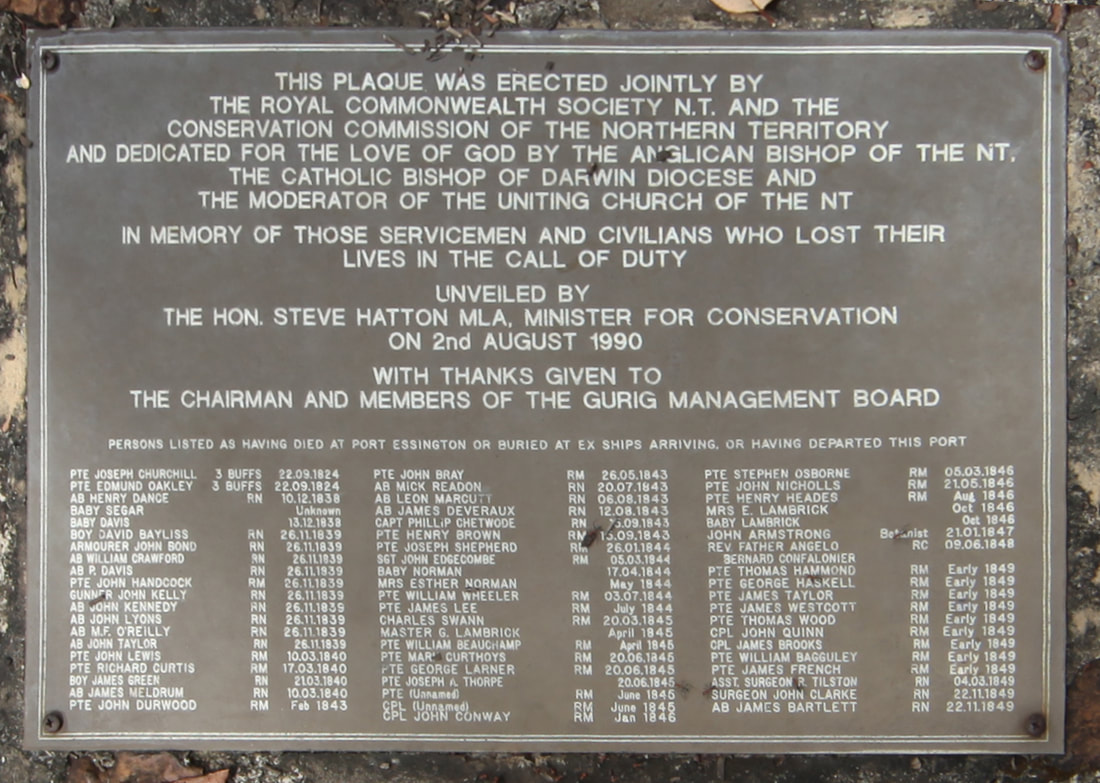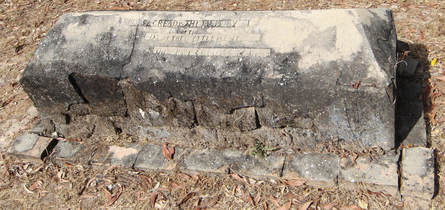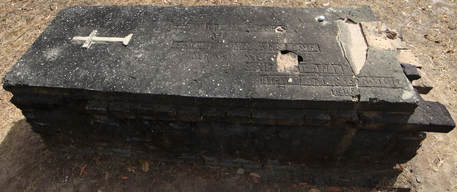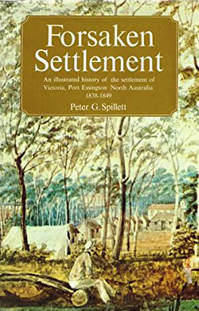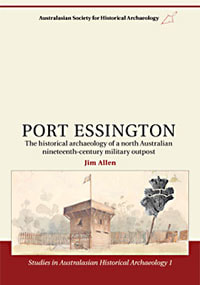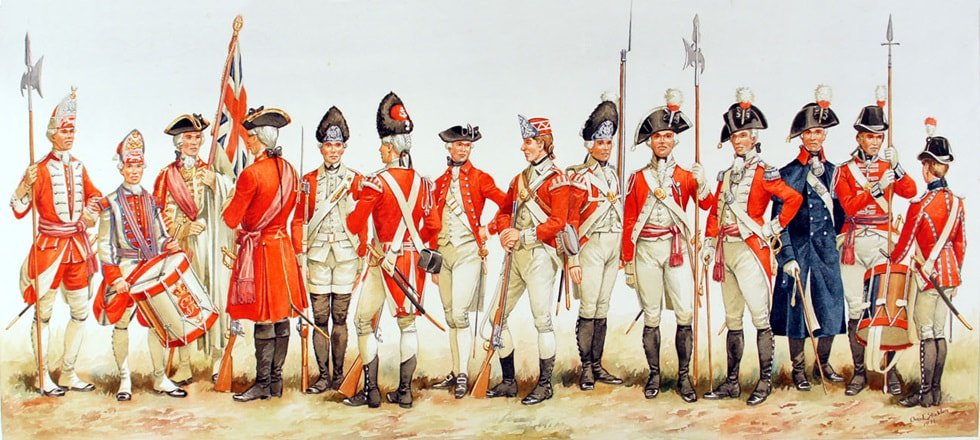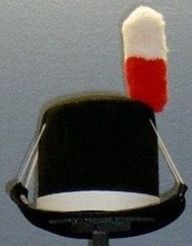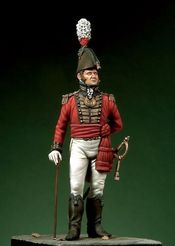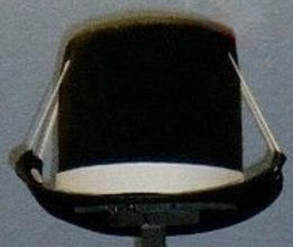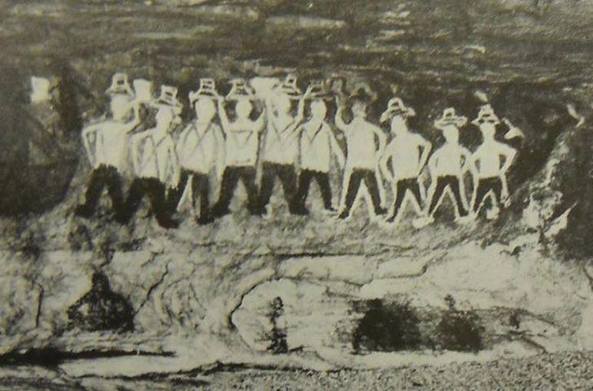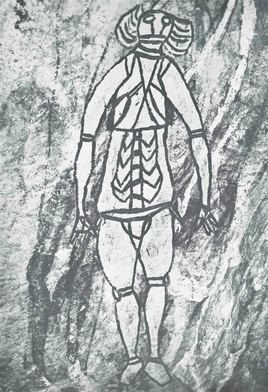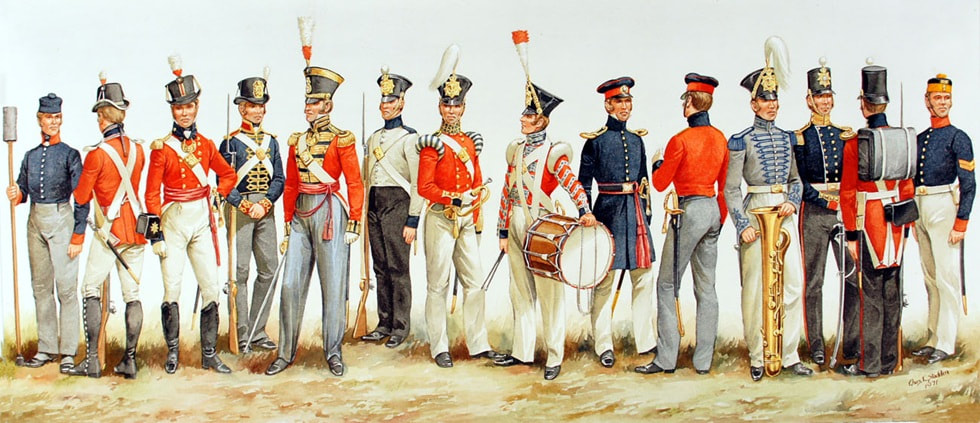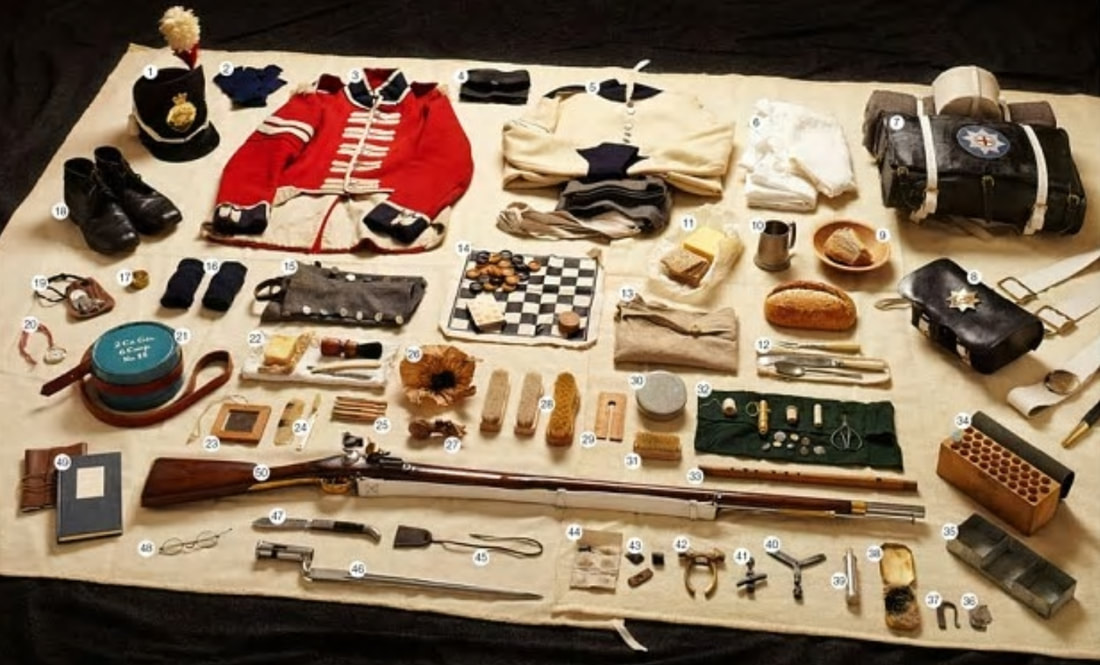THE CEMETERY
VICTORIA SETTLEMENT
PORT ESSINGTON
Emma Lambrick & Child
There is significant collapse of the foundation at centre causing the column to topple forwards – remedial work is about to begin. Of interest is the right side or shoulder of the base is missing from the 1875 image. If it was added post 1875 there should be a visible join but on which side. It is tempting to think of the 1875 image being the rear view.
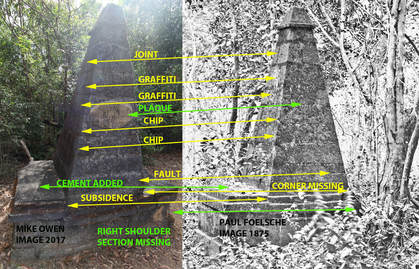
On the right of the image above - the plinth base below the pyramid is level – no subsidence as pyramid is inclined towards the other graves into the cemetery area.
Well finished, evenly dressed ashlar & a grave visible in the background which is not visible in the 1875 image.
If you go back to the 1875 image the bottom left corner of the pyramid shows signs of subsidence because the pyramid is falling towards the viewer.
The current view in the image below and 1875 view are the same - as demonstrated by several common features as identified in the image at left.
The extent of the 1913 repairs is not known beyond the addition of the plaque and speculative inscriptions on the other grave markers.
Well finished, evenly dressed ashlar & a grave visible in the background which is not visible in the 1875 image.
If you go back to the 1875 image the bottom left corner of the pyramid shows signs of subsidence because the pyramid is falling towards the viewer.
The current view in the image below and 1875 view are the same - as demonstrated by several common features as identified in the image at left.
The extent of the 1913 repairs is not known beyond the addition of the plaque and speculative inscriptions on the other grave markers.
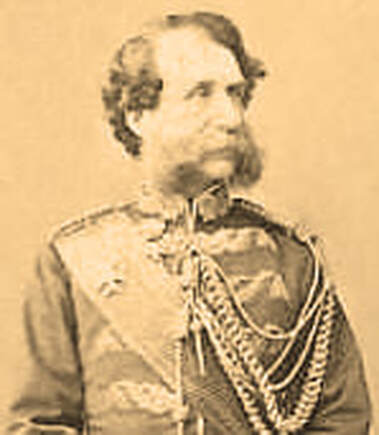 General George Lambrick
General George Lambrick
Lieutenant George Lambrick RM was Second in Command of the Military Settlement of Victoria at Port Essington between 1844-1849. He and his wife Emma Jane (nee Dillon, 1822-1846) sailed from Dublin aboard the convict ship Cadet in April 1944 with daughter Emma, who was born on 16th August 1843 at East Stonehouse in Devon. Lambrick lost his wife and two infant children at the Settlement.
On return to England he married Susan Pascoe Dillon on 27 November 1850 at Greenock in Scotland just two years before she passed away at Falmouth on 18 Feb 1852. From April 1855 to June 1857 George was posted to Ascension Island which is taking isolation to extremes. On 11 January 1860 he married Matilda Menzies the eldest daughter of General Sir Charles Menzies at St Mary's in the Castle Hastings. The ceremony took place in Scotland perhaps because such conjunction was illegal in England. They had two children George (1860-1929) & Charles (1862-1947). George Snr retired on full pay from the Royal Marines on 25 December 1877 at the rank of General and died on 30 January 1903 at Axbridge, Sunnymead in Cheddar at the age of 89. His daughter Emma died without issue at Plymouth in March 1925.
George & Emma (nee Dillon) are commemorated at Palmerston by Lambrick Avenue, Dillon Circuit, Dillon Park & Menzies Court, in the suburb of Gray "Named after Matilda Ann Elizabeth Menzies the third wife of Lieutenant George Lambrick. Lambrick was Second in Command of the Military Settlement of Victoria at Port Essington between 1844-1849. Lambrick lost his wife and two children at the Settlement and later married Matilda Menzies the eldest daughter of General Sir Charles Menzies."
The person honoured by Mrs Dillons Knob, at the Victoria River, is a source of speculation at very least.
On return to England he married Susan Pascoe Dillon on 27 November 1850 at Greenock in Scotland just two years before she passed away at Falmouth on 18 Feb 1852. From April 1855 to June 1857 George was posted to Ascension Island which is taking isolation to extremes. On 11 January 1860 he married Matilda Menzies the eldest daughter of General Sir Charles Menzies at St Mary's in the Castle Hastings. The ceremony took place in Scotland perhaps because such conjunction was illegal in England. They had two children George (1860-1929) & Charles (1862-1947). George Snr retired on full pay from the Royal Marines on 25 December 1877 at the rank of General and died on 30 January 1903 at Axbridge, Sunnymead in Cheddar at the age of 89. His daughter Emma died without issue at Plymouth in March 1925.
George & Emma (nee Dillon) are commemorated at Palmerston by Lambrick Avenue, Dillon Circuit, Dillon Park & Menzies Court, in the suburb of Gray "Named after Matilda Ann Elizabeth Menzies the third wife of Lieutenant George Lambrick. Lambrick was Second in Command of the Military Settlement of Victoria at Port Essington between 1844-1849. Lambrick lost his wife and two children at the Settlement and later married Matilda Menzies the eldest daughter of General Sir Charles Menzies."
The person honoured by Mrs Dillons Knob, at the Victoria River, is a source of speculation at very least.
The Burial Ground
Detail of the painting of the Port Essington Burial Ground by Capt. John McArthur shows a man in the uniform of the Royal Marines standing before the obelisk which is between 2 small graves - GL Lambrick died in 1845 at one year old & their baby born that year died in Nov. 1846. Their mother Emma Lambrick died Oct. 1846 - her husband was a Lieutenant in the Royal Marines promoted to Captain in October 1848. The probability is, given the facts & the impact of her tragic death, that this is a representation of Lieutenant George Lambrick RM standing before the graves of his wife Emma and their two children - it is late afternoon, the shadows lengthen to the left so the view is southward and the current plaque is on the eastern side. The obelisk appears to already lean slightly to the left. The plinth appears to have a small lip around the base of the pyramid & is equal on both sides - there are no shoulders tot he base. Perhaps McArthur faithfully depicted a scene which he witnessed on many occasions and George Lambrick stands before the front of the tomb. It is possible that the original inscription is on what is now the back and so unexamined or beneath the shoulder addition facing the artist.
Noted also is the ornate and substantial top to the square monument at the extreme left. This is now missing and instead there is a crude inscription to Captain Crawford probably appended erroneously in 1913.
Noted also is the ornate and substantial top to the square monument at the extreme left. This is now missing and instead there is a crude inscription to Captain Crawford probably appended erroneously in 1913.
Witnesses & Renovations
Peter Spillett recounts how Elsie Masson in Untamed Territory reported that 5 gravestones were found in 1913 but none bore an inscription. The Rev. GM Lambrick had found the obelisk in 1912 but the inscription had become obliterated.
A Darwin contractor, Tom Stiles was sent to Victoria settlement in 1913 to renovate the graves - Peter Spillett speculates " It is possible that the information that Stiles had to inscribe on the gravestones was provided by Jack White, an Aborigine who was reputed to have been at the settlement when he was a boy, and the pronunciation of the names by the then ancient man could have given rise to the mistake of Von Anstowe for Don Angelo."
A Darwin contractor, Tom Stiles was sent to Victoria settlement in 1913 to renovate the graves - Peter Spillett speculates " It is possible that the information that Stiles had to inscribe on the gravestones was provided by Jack White, an Aborigine who was reputed to have been at the settlement when he was a boy, and the pronunciation of the names by the then ancient man could have given rise to the mistake of Von Anstowe for Don Angelo."
The Other Graves
|
SACREAD
TO THE MEMOERY OF CAPTIN CRAWFORD 47 REGIMENT HOBART DIED PORT ESSINGTON 1838-1848 The top appears to be a solid slab but it is a thin sheet of concrete with shell inclusions. The words Port Essington are on different lines seemingly to respect the already broken surface. The same spelling of Memoery as Emma L's grave, same regiment & date of settlement (both incorrect) and absence of date of death, age etc suggest same culprit as Emma's plaque.
|
The plaque above records in the LH column Able Seaman William Crawford R DoD 26.11.1839. Doctor John Irwin Crawford RM was the senior surgeon who survived the epidemic - he arrived on the Freak in 1847 & returned to Sydney on the Meander in 1849. The 47th (Lancashire) Regiment of Foot did not serve in Australia. The 57th (West Middlesex) Regiment of Foot 'The Diehards' arrived in 1826 & relieved the Buffs at Fort Dundas in 1827 - they served in Tasmania, Sydney & Swan River as convict guards. The regiment was transferred to Madras in 1831. Victoria was an entirely Admiralty venture being designed to provide safe haven for ships in distress. Nineteen male convicts off the Bramble & Fly were loaned to the settlement to assist with works.
William Crawford was Mate on Pelorus and died in January 1841. Peter Spillett believes this is most probably the grave of Phillip Chetwode who was Captain of the Royalist and died in September 1843. He believes that the other grave, bearing the inscription to the Doctor of the settlement, belongs to Assistant Surgeon Richard Tilston RN who died on 4th May 1849.
William Crawford was Mate on Pelorus and died in January 1841. Peter Spillett believes this is most probably the grave of Phillip Chetwode who was Captain of the Royalist and died in September 1843. He believes that the other grave, bearing the inscription to the Doctor of the settlement, belongs to Assistant Surgeon Richard Tilston RN who died on 4th May 1849.
Members of the Catholic Church in Darwin have repeatedly sought to exhume the remains of Father Confalonieri and take them to Darwin which would diminish Port Essington as an historic site. It would be contrary to world best practice to remove the artefacts from their context. Darwin didn't exist when Confalonieri chose to dedicate his life to the Aboriginal people of Port Essington and it is thanks only to the inept, semi-literate, ill-informed & slipshod renovation contractor Tom Stiles that they have survived in the place where they have most meaning - for which we gratefully salute him.
Resources
|
Forsaken Settlement by Peter Spillett - An Illustrated History of the Settlement of Victoria, Port Essington
|
|
Allen, Jim. Port Essington the historical archaeology of a north Australian nineteenth-century military outpost. Sydney University Press (in association with the Australasian Society for Historical Archaeology), 2008. NTC 994.29502 ALLE - enquiries [email protected]
|
Royal Marines Uniforms
A lot of Peninsular War surplus kit would not have been an embarrassment at Fort Dundas, Wellington or Port Essington.
A Private Soldier, Battle of Waterloo 1815
- 1 The 1812 pattern Belgic Shako as worn by a centre company soldier of the Coldstream Guards during the Battle of Waterloo in 1815. It has white worsted woollen cap cords and tassels, a brass cap plate bearing a Coldstream star in the centre, a black leather cockade worn on the left hand side red and white feathered plume to indicate that the wearer is from a centre company. If the soldier was from the Grenadier Company he would wear a white plume and from the Light Company a Green plume
- 2 Fingerless woollen gloves
- 3 Soldiers red short coat bearing the rank of Corporal, it was lined with course linen and had Royal Blue facings, white worsted lace pewter buttons in two's as is the custom for the Coldstream Guards.
- 4 Black linen stock and leather stock worn around the neck
- 5 White waistcoat jacket, which had thinner sleeves than the body and would be worn under the red short coat or on its own for fatigue or off duty wear around the camp.
- 6 Linen shirts and under garments
- 7 Black painted canvas knapsack which contained all the soldiers personal equipment and possessions when on campaign, it bears the Star of the Garter with the words Coldstream Guards in the centre scroll. On the top is a rolled Greatcoat and mess tins held in place by pipeclayed buff leather straps
- 8 Leather cartridge box which contained 60 rounds of pre-packed ball cartridge ammunition, it has a Coldstream Guards star fitted to it and was carried on the right hip by a pipeclayed buff leather shoulder belt. Also visible is the bayonet scabbard and crossbelt worn on the left side
- 9 Wooden bowl containing a day’s ration of salted beef, rations would be carried in the linen haversack
- 10 Pewter mug
- 11 Hard tack biscuits and cheese, carried in the linen haversack
- 12 Knife, fork and spoon kept in a linen bag and a day’s ration of bread
- 13 Linen haversack worn on the left hip
- 14 Soldier's games, draughts and a board made from a piece of tent canvas, a pack of cards and a wooden yo-yo
- 15 Grey woollen gaiters, with leather foot straps and pewter buttons
- 16 Woollen socks
- 17 Brass sundial compass
- 18 Straight lasted shoes. The leather was rough side out and as they were straight lasted there was no right or left shoe; soldiers were expected to swop them around to prevent excessive wear on one side
- 19 Leather pouch, containing coins, dice made from flattened musket balls
- 20 Pocket watch on a length of woven binding
- 21 Wooden water canteen on a leather strap worn on the left hip
- 22 Washing and shaving kit
- 23 Small mirror in a stout wooden frame
- 24 Bone hair comb and bone handled toothbrush with horsehair bristles
- 25 Clothes pegs
- 26 & 27 Greased paper containing ‘black ball’, a mixture of tallow, beeswax and soot, used to polish and help waterproof shoes and cartridge box.
- 28 Horse hair boot brushes and bristle cloths brush
- 29 Wooden button stick, used to polish buttons and prevent clothing being stained in the process
- 30 Tin containing finely ground brick dust, which was mixed with olive oil and used as a metal polish
- 31 Small bristle scrubbing brush
- 32 Sewing kit, containing linen and sinew thread, spare buttons, wooden thimble, wooden needle case and scissors
- 33 Fife, a small, high-pitched instrument, similar to the piccolo
- 34 Wooden cartridge block used to store ammunition
- 35 Tin container stored below the wooden block, used to store additional packs of ammunition and spare musket flints
- 36, 37 & 38. Flint, steel and tinder contained in a brass case and used to light fires
- 39 Tin container for gun oil
- 40 Gun tool and worm used to strip and reassemble the Brown Bess musket for cleaning and repair, it was a simple device made up of two screwdriver heads and pointed needle used to push out the metal pins holding the barrel to the stock, screwed onto the pin is a worm which could be screwed on to the ramrod and was used to help remove cleaning cloth or unfired charges from the barrel
- 41 Feather spring clamp, used to remove the frizzen from the lock
- 42 Ramrod puller, used to remove a ramrod stuck in the barrel or stock
- 43 Musket flint with a scrap of notched leather and a piece of notched lead either of which would be placed around the flint and then helped secure the flint in the hammer
- 44 Canvas case containing spare flints, stored in the cartridge box tin
- 45 Leather lock stall, used to place over the frizzen to protect it and prevent accidental sparking that could fire the weapon
- 46 17" triangular socket bayonet which fitted onto the musket, the same fitting method was subsequently used for the modern electric light
- 47 Soldiers pen knife
- 48 Reading glasses
- 49 1807 British Army drill regulations and leather covered notebook
- 50 Brown Bess musket was in service from 1722 to 1838 - some were even shipped to the Crimea in 1854. It weighed 4.8kg and was made up of three component parts the lock, stock and barrel. It had an effective range of 100 meters but was capable of firing to 250 meters. It fired a .75 musket ball made of lead, which was contained as part of a paper tube made from Cartridge Grade paper which contained gunpowder. The soldier would remove the cartridge from the cartridge box, bite off the end to release the powder, pour a small amount into the pan and the rest down the barrel. The now empty cartridge still attached to the musket ball would then be placed into the barrel as wadding and the ramrod used to ram it down. The musket would be cocked and was then ready to fire. When the trigger was pulled the hammer containing the flint would strike the frizzen, causing sparks to ignite the gunpowder in the pan and pass through the touch hole to ignite the main charge and fire the musket ball. A well drilled soldier was capable of firing 4 shots a minute.
